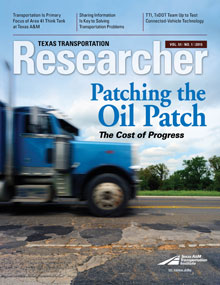Roads in South and West Texas are taking a pounding from energy-sector traffic. The affected roads are most often narrow farm-to-market (FM) roads with thin-asphalt surfaces. They’re now carrying 20 to 50 times more truck traffic than they were designed for. Weigh-in-motion data indicate that many of these trucks are also overloaded.
The Texas Department of Transportation (TxDOT) is looking for ways to widen and strengthen these roads, though rehabilitation efforts are often hindered by a lack of detours around the roadway needing repairs. For safety reasons, TxDOT requires all work to be performed during daytime hours. The roads must be open to traffic before dark, which restricts a contractor’s rehabilitation options.



Texas A&M Transportation Institute (TTI) researchers Tom Scullion and Stephen Sebesta approached TxDOT with a rehabilitation method known as foamed asphalt. The method is currently being used internationally to successfully deal with similar energy-sector traffic.
“Texas tried foamed asphalt 15 years ago, before anybody else did. It didn’t work because the contractor wasn’t properly prepared and did not do the up-front site evaluation, which is critical,” Scullion, manager of TTI’s Flexible Pavements Program, says.
The foamed asphalt recipe is simple. Heat asphalt to 320 degrees. Introduce a small stream of water. When the water hits the asphalt, it evaporates instantly. As the water expands, it carries the asphalt with it, creating bubbles of asphalt. The foamed asphalt is thoroughly mixed with recycled pavement material and does a very good job of spreading and coating it. The pavement material can then be compacted immediately, and the material cools rapidly.
“In the laboratory this is probably the most underwhelming treatment you’ve ever seen. Where does the asphalt go? It can’t be easily observed. However if you grab a handful of the treated material and squeeze it very tightly, you’ll see tiny spots of asphalt on your hand,” Scullion notes.
Other methods such as cement stabilization require more water than foamed asphalt. They also take longer to dry and cure, and they don’t stand up to early traffic loads. Foamed asphalt allows contractors to rehabilitate a section of roadway and open it to traffic in a few hours.
However, the true benefit of foamed asphalt only becomes apparent when you check the moisture susceptibility of the treated material. Measurements at TTI have shown retained strengths of 70 to 80 percent when the samples are submerged in water for 24 hours. This property recently proved the value of foamed asphalt on a project on FM 99 in TxDOT’s Corpus Christi District.
On FM 99, they finished the job on a Friday. The road was to be surfaced on Monday. It rained 4 inches over the weekend. The water ran off. No damage. Any other treatment would have been a disaster with that amount of rain on it,” Scullion says. All test sections are constantly monitored to see how they’re performing.
Any road that’s a candidate for foamed asphalt must undergo a full engineering evaluation to see what’s underneath the surface. Employing ground-penetrating radar and a falling-weight deflectometer, and evaluating core samples, are necessary before any rehabilitation begins. This up-front testing prevents unwanted surprises later on.
While it costs a little more initially to use foamed asphalt, Scullion feels that its life-cycle benefits far outweigh the initial expense. “It appears foamed asphalt is a good product that, even under intense heavy traffic loads, will last for 10 years. The roads will be safer and will last longer,” he says.

